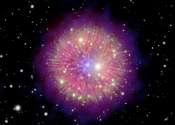Milky Way's super-efficient particle accelerators caught in the act
Thanks to a unique "ballistic study" that combines data from ESO's Very Large Telescope and NASA's Chandra X-ray Observatory, astronomers have now solved a long-standing mystery of the Milky Way's particle accelerators. They ...








